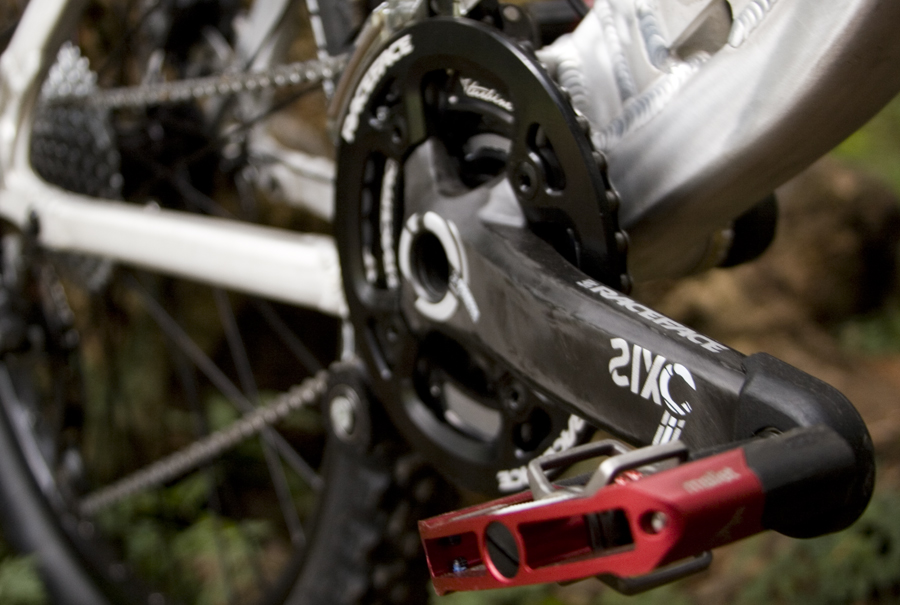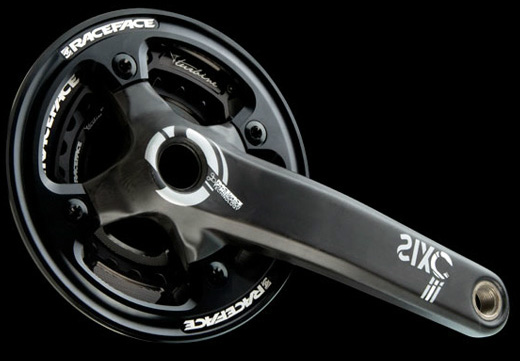
RaceFace SixC Cranks
Reviewed By Steve Dempsey
Weight: 745 Grams (With BB and Pedal Boots)
Design
Introduced in 2010, the SixC line brings two words to mind; light and strong. These cranks can take a beating. Based in British Colombia, RaceFace ensures crank arm strength by using the Carbon Optimization Process; a pressure molding system that focuses on maximum strength to weight ratio. The bottom bracket spindle is good ol’ chromoly steel and is molded into the drive side crank-arm, increasing rigidity. Race Face further stands behind their product when advertising that the pedal inserts molded with RF’s proprietary process eliminate creaks or loose inserts down the trail. Installation was simple. The EXI spline interface was high quality and had a comforting, snug fit. An 8mm hex torque wrench finished the job. RaceFace’s integrated bolt puller cap made removal just as simple as instillation.
Durability
Our first intuition was to distrust the long-term durability of carbon mountain cranks, for rocks are just so dang hard. Other than few clear coat blemishes, our SixC cranks saw no structural damage whatsoever. Through lack of being smooth, testers ensured that the crankset took numerous impacts during the 110 hour test period. Rubber pedal boots made short work of the multiple pedal strikes. We appreciated the fact that the pedal boots are included. Rock impact to the actual crank arms were the only damaging blows and these were strictly cosmetic. Our skepticism has been subsided. RaceFace built these cranks to last.
Power Transfer
RaceFace succeeded in the keeping things stiff. Power transfer to the pedals is superb, which means more watts are going into forward motion. A novel thought. Fire road climbs are tough enough as it is, so we appreciated the lack of discernible flex. Any acceleration to overcome trail clutter was enhanced by the responsive pop in the SixC cranks.
Shifting
The 26t / 36t combination worked well on our application. The gear ratio was great for climbing and we did not feel we spun out while descending. Chain ring life appears normal, with signs of normal wear and tear. The bash-guard setup was utilized on several rocky, step-up climbs. Race Face offers an assortment of other gearing options, so riders can cater to their local environment and individual leg strength.
Bottom bracket
Living in the Pacific Northwest, bottom brackets take exorbitant amounts of crud and mud. Dedicated riders may need BB replacement every four months. We were excited see if the Race Face Team XC BB would pass muster. After 110 hours of testing, both drive and non-drive side bearings are still performing well, with no signs of premature wear. Other than some quick, post-ride hose spray; these bearings have been entirely maintenance free.
Summary
In putting the firm sticker price aside, the Race Face SixC is of the sexiest cranksets available for the aggressive trail rider. It is XC light and DH strong. We appreciate the simplicity of the design; strong, hollow carbon paired with cro-mo steel. No proprietary tools were needed for installation or removal, so basic trailside maintenance is feasible. Strength to weight ratio is impressive. Grams are feathery at 745g on our scale. After 110 hours of testing, we found the BB to spin a freely as the day it came from the factory. Durability is good, but just keep in mind that those expensive carbon cranks can’t hold their movie star good looks forever.
Check the Cranks out at: www.RaceFace.com
